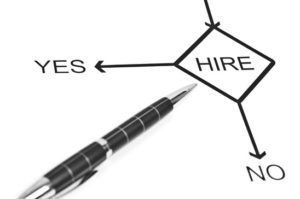
It’s easy to hire someone who looks good on paper, and all too often that’s what happens. If the resume is terrific and their references are glowing, they get hired.
But if a new employee isn’t as good in person as they appeared on paper, often the business owner will keep looking for reasons to make it work. Even after giving an employee additional training, and setting goals that are missed, the owner would rather settle for a below-average employee than let them go. It’s so easy to hire and so difficult to fire.
You know the difference between good employees and employees who aren’t as good. A good employee is loyal and emotionally engaged with their job. They get in and get things done, and they do it well. They are easy to work with and others want to work around them.
Like What You’re Reading? Consider our
Employee Manual
Specifically for construction, fully customizable, edit to match your company policies
Not-so-good employees show up and do just enough to collect their paycheck. They like to stir the pot by finding fault with others and what they do. They contribute little to the company or its ability to get the job done. These folks should be given a transfer to the competition.
Make it your policy to hire slowly and fire quickly. It’s getting harder to find good people who are willing to do their job, but a bad employee can cost you a lot of time, heartburn and money. It’s better to get rid of someone who is costing you money than to keep them around.
One way to hire slowly is to use the three-stage hiring process described in Chapter 6 of Markup and Profit Revisited. This enables you to immediately hire someone who looks good, but they aren’t full employees until you’ve had a chance to see their work.
It’s also important to have your employee policies clearly outlined in your employee manual. This allows all employees to know exactly what their job is. They need to know what constitutes a violation of company policies and what offenses can lead to termination. You need to be specific and remember that, just like your client contracts, it’s better to put in too much information than to put in too little. (We offer a customizable Employee Manual as a starting point.)
The employee manual needs to include an agreement signed by the employee that states, among other things, that they understand they are working “at will”. At-will employment is legal in most states and allows an employee to be fired for any reason and without warning. On the flip side, it also allows the employee to quit at any time and without warning. At-will employment won’t protect you from all claims of wrongful termination because you’re still bound by federal statues covering discrimination and family medical leave, but in most situations it does allow you to easily fire an underperforming employee. Don’t try this without a signed at-will agreement and without first confirming that your local laws support at-will employment.
The bottom line is this: If you have an employee who has clearly violated the company policies and there is no doubt about it, or if you have an employee who just isn’t working out and a little voice in your head says they should go, terminate them and move on.
The knowledge and experience Michael Stone gained in his 60+ years in construction has helped thousands of contractors improve their businesses and their lives. He is the author of the books Markup & Profit Revisited, Profitable Sales, and Estimating Construction Profitably, and is available for one-on-one consultations.

